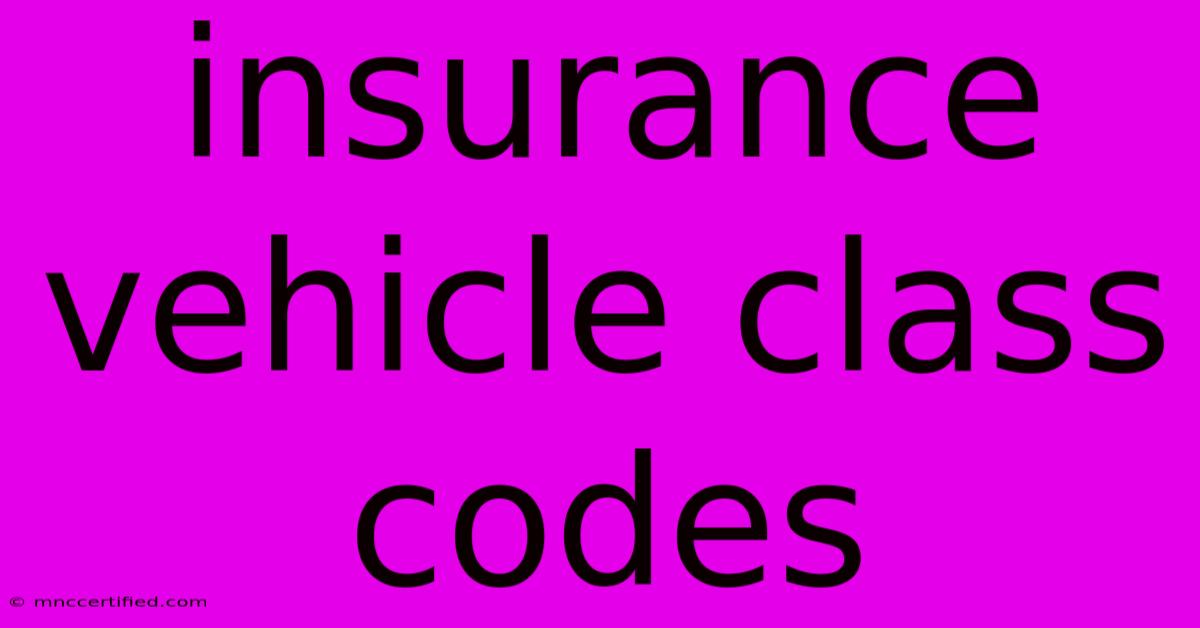Insurance Vehicle Class Codes

Table of Contents
Decoding Insurance Vehicle Class Codes: A Comprehensive Guide
Understanding your insurance vehicle class code is crucial for getting the best car insurance rates. These codes, assigned by insurance companies, categorize vehicles based on various risk factors, directly impacting your premium. This guide will demystify vehicle class codes, explaining what they are, how they're determined, and how they affect your insurance costs.
What are Insurance Vehicle Class Codes?
Insurance vehicle class codes are alphanumeric codes used by insurance providers to classify vehicles based on inherent risk. These risk factors include:
- Vehicle type: Sedans, SUVs, trucks, motorcycles, and even RVs all fall into different classes due to their varying repair costs, theft rates, and accident probabilities.
- Vehicle value: More expensive vehicles typically command higher premiums, reflecting the greater financial loss in case of an accident or theft.
- Safety features: Vehicles equipped with advanced safety technologies like airbags, anti-lock brakes, and electronic stability control might fall into lower risk classes.
- Performance capabilities: High-performance vehicles, known for their speed and power, are often categorized as higher risk due to the increased potential for accidents.
- Repair costs: Vehicles with expensive parts and complex repair procedures will usually attract higher insurance premiums.
These factors are combined to generate a code that accurately reflects the risk associated with insuring a particular vehicle. It's important to note that these codes vary slightly between insurance companies. While the general principles remain consistent, the specific code assigned to a particular vehicle might differ from one insurer to another.
How are Vehicle Class Codes Determined?
Insurance companies employ a variety of methods to determine a vehicle's class code. These include:
- Vehicle Identification Number (VIN): The VIN provides a wealth of information about the vehicle, including make, model, year, and even optional features. This data forms the basis for assigning the initial class code.
- Make and Model: Even without the VIN, the make and model are key identifiers in determining the vehicle's class. Insurance companies maintain databases containing the historical claims data for each make and model, contributing to risk assessment.
- Optional Features: Features like a sunroof, premium sound system, or navigation system can subtly influence the final classification, although their impact is often less significant than the core vehicle characteristics.
The process involves complex algorithms and statistical modeling, considering historical claims data, repair costs, and other relevant factors. This ensures a fairly accurate risk assessment for each vehicle.
How Vehicle Class Codes Affect Your Insurance Premiums
Your vehicle's class code is a significant factor in determining your car insurance premium. A higher class code generally translates to a higher premium, reflecting the increased risk associated with that vehicle. This is simply because the insurer anticipates a higher likelihood of claims and potentially higher repair costs.
Understanding your vehicle's class code empowers you to:
- Compare quotes effectively: You can use the code to compare quotes from different insurers more accurately, as it provides a common benchmark for risk assessment.
- Negotiate your premium: If you believe your vehicle's classification is inaccurate, you can provide supporting information to your insurer to potentially negotiate a lower premium.
- Choose a vehicle wisely: When purchasing a new vehicle, considering the potential impact of the class code on your insurance premiums can be a smart financial decision.
Finding Your Vehicle's Class Code
Unfortunately, there's no universal database readily accessible to the public that lists every vehicle's class code across all insurers. The best way to determine your vehicle's class code is to contact your insurance provider directly. They will be able to access this information from your policy details.
Optimizing Your Insurance Costs
While you cannot change your vehicle's inherent class code, you can influence your overall insurance premium by:
- Maintaining a good driving record: This is the single most significant factor influencing your insurance costs.
- Increasing your deductible: A higher deductible will usually lead to lower premiums.
- Bundling your insurance: Bundling your car insurance with other policies, such as homeowners or renters insurance, often results in discounts.
Understanding your insurance vehicle class code is an important step in managing your car insurance costs effectively. By understanding the factors that influence this code and proactively managing your risk profile, you can work towards securing the best possible rates.

Thank you for visiting our website wich cover about Insurance Vehicle Class Codes. We hope the information provided has been useful to you. Feel free to contact us if you have any questions or need further assistance. See you next time and dont miss to bookmark.
Featured Posts
-
Spurs Vs Roma Official Starting Lineups
Nov 29, 2024
-
Does Insurance Cover Purewick
Nov 29, 2024
-
55 Amazon Black Friday Deals
Nov 29, 2024
-
Vitos Best In Show Victory
Nov 29, 2024
-
Detroit Lions Key Players Active
Nov 29, 2024